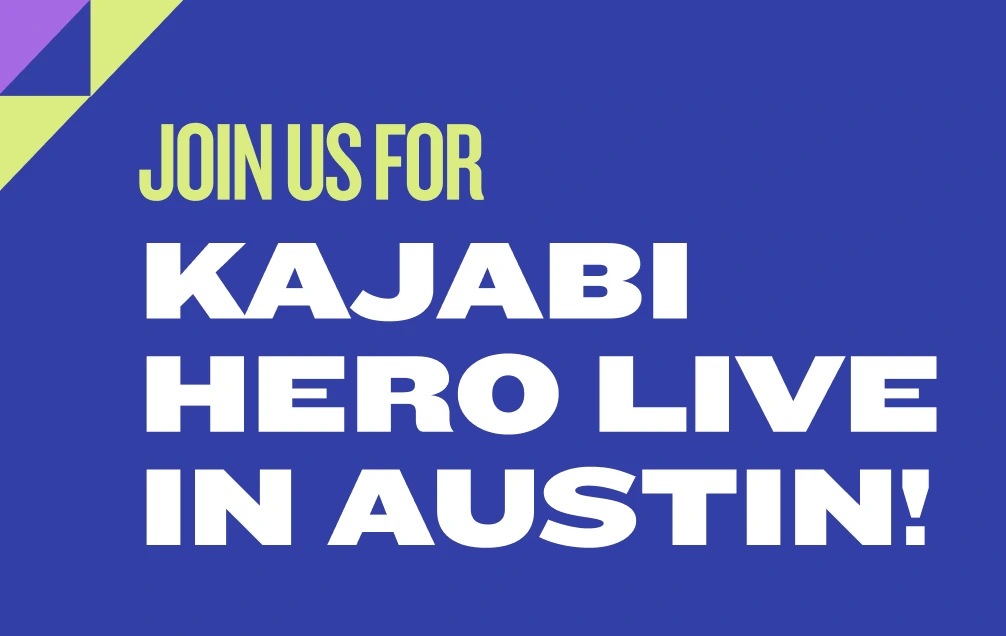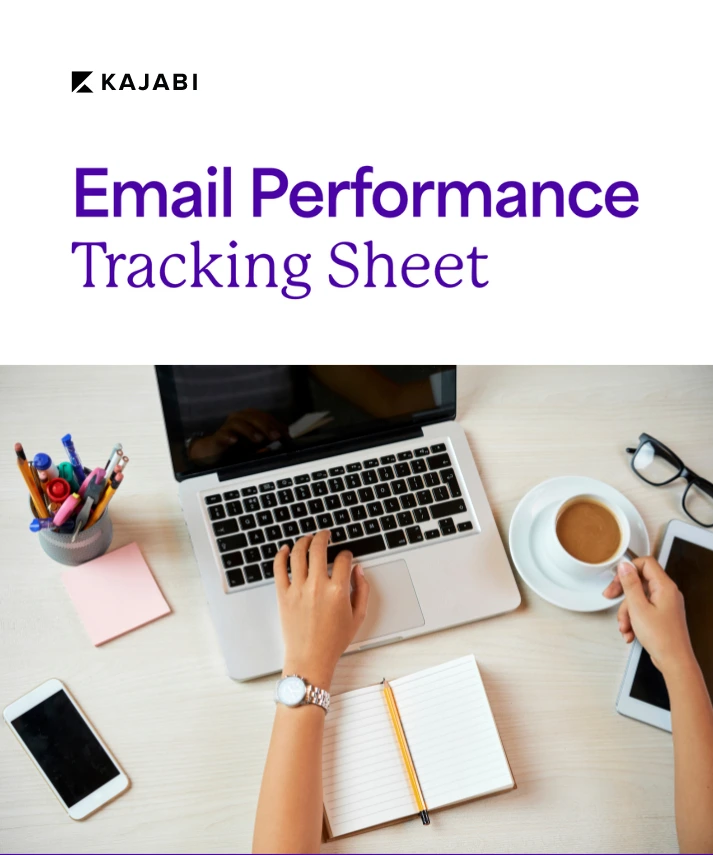
Retargeting and Remarketing: What are they and how do they work?
Get free expert insights and tips to grow your knowledge business sent right to your inbox.
To attract your best prospects, you need to stay top of mind. For that, nothing beats digital marketing with retargeting and remarketing.
In this guide, you’ll learn what retargeting is and what remarketing is. We’ll go over how they’re different and how to apply both to better improve your knowledge commerce business.
Retargeting vs. remarketing
Retargeting and remarketing are often used interchangeably. It’s an understandable mistake since both target and engage prospects who've expressed interest in your brand. But they use different tactics to achieve that goal.
Retargeting places paid ads in front of customers who have visited your social media profiles or website. Remarketing uses emails marketing to:
- Follow up on a product they downloaded from your website
- Remind prospects that they left a product in your shopping cart
- Offer upsells to customers who recently purchased a product
Retargeting and remarketing are easy to do with digital marketing tools. Let’s look at how retargeting and remarketing work, and then we’ll explore how you can use these strategies to sell more of your digital products.
What is retargeting?
Retargeting is a digital marketing strategy that places ads for the product people view on your website after they leave. The goal: to bring them back to complete the purchase.
According to Retarget, 98% of buyers don’t purchase on their first visit to a website. Retargeting is a calculated, strategic way of reminding shoppers about their initial interest in your product.
According to a study by Barilliance, returning customers are 65 percent more likely to add items to their carts than first-time visitors. So it’s important to get them to come back.
Jeff Jarrett, VP of Global Digital Marketing at Kimberly-Clark, agrees. He reports 50–60 percent conversion rates from retargeting.
“If a consumer visits our property and expresses an interest, there is an opportunity to take advantage of that interest. We have seen some good results. Consumers who visit the brand site are 20 percent more likely to act on a message than a consumer who has not expressed this interest.”

Source: TurnKey Marketing
How does retargeting work?
To understand retargeting, let’s look at an example of a common scenario:
A visitor looks at your products on your website and leaves without adding anything to the cart. When that same visitor later surfs the web, they see an ad for the product they were viewing. The ad reminds them of your brand and hopefully gets them to return to make a purchase.
This is done through retargeting. Retargeting platforms use a cookie-based technology with simple Javascript codes. Once the code is placed on your website, you’re able to anonymously follow your visitors around the Web, showing them ads for the product they were just viewing.
Here's how it works:
- You place a code on your website. (This code is invisible to visitors. It’s sometimes referred to as a “pixel.”)
- When you have a new visitor, this code drops a browser cookie.
- Later, when the visitor browses the web, cookies follow them and collect browsing data for website owners.
- Marketing teams use this data for serving ads to visitors again.

Source: Semify
What is remarketing?
Remarketing is the process of reaching out to prospects and customers to re-engage them. All remarketing campaigns are triggered by the user’s behavior on your website. It’s usually done through email marketing campaigns that you set up in advance.
Remarketing campaigns are incredibly effective in driving conversions. Campaign Monitor found that marketers experienced a 760% increase in email revenue from targeted, segmented campaigns.
Remarketing emails might include:
- Follow-up sequences after a prospect downloads a lead magnet
- Deals or sales on services or products related to the visitors’ past purchases
- Next-step offers for new customers
- New offers or sales.
How does remarketing work?
To set up remarketing campaigns for your prospects and customers, you’ll need to evaluate the customer journey. Where do you need to engage with them to move them along the customer journey? What actions do you want to drive?
Sales funnels are a good example. When a prospect signs up for a lead magnet, an email sequence is triggered. Each day, they get an email that shares useful information or makes an offer that will help them implement what they’ve learned in the lead magnet.
If they buy a product, the promotional email sequence is stopped. Instead, the customer is put into an upsell email campaign. They then receive regular emails that explain how to use the product, share tips and tricks, and upsell a premium version or add-on that will give better results.
Platforms like Kajabi make remarketing easy to do in an automated way thanks to features like Pipelines and its robust email marketing capabilities.
Using digital retargeting and remarketing in your business

Your prospects are already browsing the internet. Retargeting and remarketing puts your message in front of them, no matter where they browse. That helps you stay competitive and drive traffic back to your website.
Retargeting brings 26% of lost consumers back to finalize a sale. That’s enough reason for most entrepreneurs to give it a try. But let's take a closer look at the benefits of retargeting and remarketing:
- It lowers the cost of customer acquisitions. It's less expensive to convert visitors who've already expressed an interest in your brand than go after brand new users.
- It helps raise brand awareness. Visitors may not learn a lot about your brand on their first visit, but they can learn more about you through a remarketing campaign.
- It's data-based: With retargeting and remarketing campaigns, you're using visitor data to target ads, instead of relying on assumptions. This ensures your advertising dollars are spent on the most relevant customers only.
When should you use retargeting and remarketing?

Both retargeting and remarketing help you increase your customer base. The question is, when do you use which strategy?
Use remarketing campaigns when:
- You have a limited budget.
- You already have an email list of interested prospects.
- You want to add much more content to your ad, and not just a headline and product photos. This may include additional information about your product features, upselling a product, or adding offers and coupons. Emails are a better way to convey this information.
- You run an ecommerce business and want to remind customers of their abandoned cart purchase. These can supplement platform automations for checkout. For example, if you run a Shopify store, you can use Shopify abandoned cart tools to solve your cart abandonment problems.
Let's say you sell online courses, like health coach Lauren Bongiorno. Lauren offers various free downloads on health and wellness on her website, which helps her build her email list.

When someone subscribes, she can push them to her courses and consulting services with an email remarketing campaign. In the campaign, she could explain the benefits of her course and convert subscribers into paying students.
On the other hand, retargeting campaigns are a lucrative option when:
- You're looking to attract a new audience that has never purchased on your site but has interacted with it in specific ways.
- You want to introduce new collections of your store. Visitors who left your site without making a purchase may have not liked your old collection, but they may be interested in new offerings.
- You don't have an email list yet, but still want a way to market to interested prospects.
Let's look at an example of how antique chair creator Chair Whimsy might use retargeting campaigns.

When visitors land on Chair Whimsy’s “Courses” page, it could drop a cookie. Then, after visitors leave, they would be shown targeted ads related to Chair Whimsy’s courses. It might also navigate to the shopping cart.
It's worth noting that using a mix of remarketing and retargeting is the best way to maximize ROI and drive prospects further down your sales funnel. Thus, along with running retargeting, Chair Whimsy could also use email remarketing to:
- Announce the launch of new courses
- Offer a discount code on a featured course
- Share a student success story
Types of retargeting and remarketing campaigns
Depending on the data used to serve ads, retargeting and remarketing campaigns can be categorized into seven different types:
- Search Retargeting
- Site Retargeting
- SEO/SEM Retargeting
- Email Retargeting
- Contextual Retargeting
- Engagement Retargeting
- Social Retargeting

Source
Let's go over each of these below:
Search retargeting
Search retargeting helps you target search engine users who've searched for a specific keyword or phrase relevant to your business.
Search queries on Google and other search engines essentially tell marketers what users are looking for. If the query is relevant to your business, it makes sense to serve up ads to these users. Their search activity tells you they're in the market to buy.
Let's say you sell sneakers online, and a user searches for "best sneakers buy." Viola, you've found a potential candidate for retargeting.
Search retargeting helps you reach out to interested prospects, even if they haven't visited your website. It's solely based on terms, keywords, or phrases that they search for.
Site Retargeting
Site retargeting is one of the most common forms of retargeting. It targets individuals who have visited your website.
As explained earlier, you start with a snippet of code on your website, also known as a pixel. When a visitor comes to your website, the pixel drops a cookie into their browser.
The cookies allow you to "tag" these individuals and follow them around the internet. As they continue browsing the web, your ads serve as a reminder for them to complete a download or purchase.
It's important to recognize only a few actions as “tag-worthy,” so you don't serve ads to visitors who aren’t likely to buy. The best approach is to use site retargeting for pages related to conversion:
- Shopping cart
- Product pages
- Download pages
A newer and more creative way of site retargeting is programmatic site retargeting (PSR). The difference between PSR and classic site retargeting is the type of data they use to serve up ads.
PSR uses easy more data points, such as keywords, keywords searched for before coming to the site, time spent on site, and pages visited. It assigns importance to each visitor, then serves relevant ads.
SEO/SEM retargeting
SEO/SEM retargeting is an underutilized method. It combines search and site retargeting to provide more insight into why an individual comes to your website in the first place.
It takes into account the search terms they looked up before coming over to your site. This helps you delve deeper into a website visitor's intention.
Email retargeting
Email retargeting lets you retarget individuals based on their engagement with your emails. Someone who clicks a link in your emails is more invested in your brand than someone who doesn’t open it at all. Therefore, they're a better candidate for retargeting emails.
Contextual retargeting
Contextual retargeting involves swapping pixels between websites and going after each other's visitors. For instance, an airline website and a hotel website may target the same visitors based on destinations they search. Contextual retargeting helps you target new customers, even if they never visit your website.
Engagement retargeting
Engagement retargeting allows brand companies to get the audience of anybody who has:
- Liked their posts
- Commented on their posts
- Shared their posts
- Visited their page
- Sent their page a message
- Interacted with their ads
Social retargeting
Social retargeting is an underutilized yet effective way of increasing engagement. It refers to showing ads for a product on social media platforms.
Let's say you visit a website to search and view a product but you leave the website without making a purchase. When you browse on social media platforms like Facebook, you may see an ad of the same product on the platform.
Modern social retargeting observes micro-content utilization. It also takes into account what users are clicking on, reading, and sharing, to show relevant ads.
How to create retargeting and remarketing campaigns

Lets go over the step-by-step process for creating retargeting and remarketing campaigns:
Step 1: Prepare your website or email list
Before you start running retargeting or remarketing campaigns, you'll need the following:
Pixels for retargeting: You'll need to place pixels or Javascript codes on your website to collect data.
Every time you have a customer visiting your landing page or website, the attached pixel drops a browser cookie in the customers’ browser. After this customer leaves your page and visits other websites, this pixel allows your provider to know that this visitor should start seeing your ads. You can easily add marketing pixels to your Kajabi sites.
Email list for remarketing: For effective remarketing, you'll need an email list of customers who may be interested in your product. For example, if you want free trial customers to upgrade to your paid membership, you might set up a remarketing campaign to send them the benefits of upgrading.
To show retargeting ads to email subscribers, upload your list of emails into your remarketing platform. Your customers will start seeing your ads in their inboxes. You can support that campaign by sending personalized emails that make the same offer.
That’s why it’s so beneficial to have robust email marketing capabilities built into the platform you’re using. For example, Kajabi includes email marketing sequences that are tailor-made for remarketing campaigns.
Step 2: Choose a way to segment audiences
Audience segmentation helps you divide your audience into segments or groups, based on their interests or the products they’ve purchased. Segmentation helps you determine when you show which ads to which users.
For retargeting and remarketing campaigns, your audience may be segmented based on:
Time: This type of segmentation let's you show ads based on:
- The time between a customer’s visit to your site and when they should see your first ad. First time visitors to your website may find it a bit alarming if they only spend a few seconds on your website and start seeing ads immediately after.
- The frequency with which users see your ad. When you show the same ads repeatedly, it can feel spammy.
- The time between a customer’s first visit to your site and when they stop seeing your ads. It’s important to stop showing ads after a specified time, so you don’t deliver ads after they’ve lost interest.
Behavior: While browsing your website, your customers may either be:
- Interested, which means they browse through your website content and look at different pages, like your blog, the About us page, or the pricing page.
- Not interested, which means they spend little time (maybe seconds) on your website without navigating to other pages. These people often exit immediately.
The “not interested” group has very low intent. Offering them ads will only increase your expenditure. They won’t give you a good return on investment (ROI).
The “interested” segment has high intent. They’re most likely to return to your website. They might actually be interested in buying something if they’re served the right ad messaging.
Existing customers: This segment is most likely to convert. They’re already familiar with your products. You can launch your remarketing campaign for existing clients whenever you insert a new feature in your product.
This works well for clients who aren’t active. New feature updates can convince them to start using your product regularly. Existing clients are also great candidates for upselling and cross-selling activity.
Proper audience segmentation plays an important role in the success of your remarketing campaign. When you select relevant audience segments to target your campaign, you're likely to get better results.
Step 3: Set up your retargeting campaign
Apart from getting your website or email list ready for retargeting and remarketing, you also need an advertising platform to run your campaign.
Here are a few of the most popular platforms available for retargeted advertising.
Google Ads

Advertisers who have an existing Adwords account can easily start their remarketing campaign with Google Adwords. Its retargeting solution helps you re-engage visitors when they:
- Visit other sites that are part of the Google Display Network
- Use Android apps
- Browse on YouTube
Google offers three pricing models: Cost Per Thousand Impressions (CPM), Cost per Click (CPC), and Cost per Acquisition (CPA).
To set up your remarketing campaign with Google AdWords:
- Sign in to your Google AdWords account.
- Click on Shared Library, and select Audiences.
- Click on Audience sources, then Set up Tag.
- Once complete, click on Create and continue, and then Done.
Within a day or two, your tag will start collecting cookies from your website visitors. When a new visitor lands on your webpage, they will be added to your remarketing audience list.
Adwords also gives you the option of creating customized lists to deliver more targeted ads. You also have the option of running tests such as ad testing, custom combination testing, frequency cap testing, bid testing, and post-click landing page testing for increasing the efficiency of your campaigns.
A few ways to implement Google Adwords remarketing are:
- Dynamic remarketing: Show specific services or products to visitors who looked through your website.
- Standard remarketing: Show ads to past customers as they visit Display Network applications and websites.
- Mobile Apps: Show ads to customers who have used your mobile website or mobile app.
- Video Remarketing: Display ads to customers who have watched your YouTube videos.
- Email list: Upload a list of your email addresses. Then, when these customers check their email, Google will retarget ads to them.
Facebook Ads

Facebook ads are similar to Google Ads. But instead of showing ads on other websites, Facebook shows ads on it's own platform. Facebook refers to remarketing as “custom audiences.”
Here's how it works:
- Visitors come to your website.
- They're tagged with a tracking code.
- Later, when they browse Facebook, your ads show up, reminding them of your brand.
To start your Facebook remarketing or retargeting campaign, you must have an account on Facebook for Business.

Here's how to set up your campaign:
- In Facebook Ads Manager, select “More Tools,” then “Audiences.”

- Choose the type of remarketing you want to do: custom audiences, lookalike audiences, and saved audience.
- If you choose the “Custom Audience” option, you can reach out to customers who have visited your website with relevant ads.
- The “Website” tab lets you choose the audience you wish to target. Audience options include “All website visitors,” “People who visited specific web pages,” and “Visitors by time spent.”
- After you’ve selected an audience, Facebook will provide you with a pixel code known as “Facebook Pixel.” Place this code on your website to track visitors.
Kajabi empowers you to embrace digital marketing and remarketing through integrations with Facebook Pixel and other useful integrations.
AdRoll

If you wish to take your remarketing campaign to the next level, consider this retargeting ad platform. It has access to several advertising partners such as Facebook, Google, Yahoo, Twitter, and Bing.
AdRoll helps you to make your display, email, and social advertising work together for accelerating business growth. It offers various personalization and automation features to measure, structure, and sync your marketing efforts. Interestingly, AdRoll helps you create and manage retargeting campaigns across 500+ advertising exchanges and partners with ease.
Creating a retargeting campaign using AdRoll is easy. When someone visits your website, AdRoll places a cookie in their browser. This allows you to target ads to them once they leave your site.
Using this cookie, AdRoll then places your product in front of that customer across the web, social media, and across multiple devices.

Examples of retargeting and remarketing campaigns
Here are a three examples for retargeting and remarketing campaigns:
Example 1: Grammarly
Grammarly uses various channels, mediums, and placements for its remarketing campaign. Here's an example of one of their banner ads:


Grammarly also runs engaging YouTube ads. For instance:

Example 2: Amazon
Amazon is a leader when it comes to remarketing. For example, if you search headphones on Amazon, the next time you're on the web, you'll see an ad for them.


Example 3: Sales Hacker
Here's an example of a remarketing campaign from popular sales blog Sales Hacker.

The website uses email remarketing to promote upcoming events and blog posts to email subscribers. The goal is to increase engagement with the Sales Hacker brand.
Best practices for retargeting and remarketing
To get the best results from your remarketing and retargeting campaigns, let's go over some best practices for each.
Showcase products you know customers are interested in
When customers visit a product page, it's a clear indication they're interested in it. A gentle nudge from your retargeting campaign might be the incentive they need to buy.
For instance, Google Dynamic remarketing helps you to show previous visitors ads that contain products and services they viewed on your site. Campmor, an outdoor recreation equipment retailer saw 300% higher CTR, 37% lower cost-per-conversion, and a 16% higher conversion rate by using dynamic remarketing.
Optimize your ads and landing pages
When you show the same ad to a visitor multiple times, it can cause ad blindness or fatigue. Here are some ways to optimize your ads, so that’s less likely to happen:
Check your ad frequency: Frequency capping refers to limiting the number of times a visitor views your display or video ad over a given period of time. Set your frequency cap to get the highest reach.
You may need to decrease your frequency cap for individual visitors. But make sure your ads are shown to more people overall. This feature is available in both Google and Facebook remarketing campaigns.
Use ad rotation: While limiting the frequency of your ads, it’s also important to avoid showing the same version of an ad repeatedly to the same person. Create four to five different versions of your ad. Then set them to rotate, so you get more ad clicks.
Split testing: This refers to testing several ad sets against each other to find out which one performs the best. This is an important part of ad optimization, helping you to improve your ad performance and increase customer conversion rates.
Use cross-selling and upselling
Cross-selling refers to selling different products and services related to previous purchases by an existing customer of your brand. Upselling means selling a higher-value version of a product purchased by a customer.
Facebook provides the option of running both cross-selling and upselling campaigns. It automatically selects relevant items from the product set you choose to display in ads. For example, if customers frequently purchase baseball bats and baseball gloves together, Facebook learns to cross-sell gloves whenever a bat is sold.
Even Google provides the option of running dynamic ads for “converted customers,” so you can show relevant upsell and cross sell ads. These campaigns help you increase the reach and relevance of your dynamic ads.
Use sequential engagement campaigns
Sequential engagement campaigns refer to showing ads in a certain order to your targeted audience. For example, ad A will be delivered to a customer before ad B is delivered.
Sequencing ad campaigns help you tell a story about your brand and engage users in a unique way. According to a study by Facebook, campaigns that tell a brand story before asking people to buy something are significantly more effective than campaigns focusing on direct response.
Remarketing best practices
Follow up on abandoned shopping carts
Over 75% of people abandon their shopping carts online. Two important reasons for this are high dispatching costs and discount codes that don't work. Abandoned cart emails act as a reminder to customers that they left an item in their cart, persuading them to complete their purchase.
According to Moosend’s research:
- 45% of cart abandonment emails are opened
- 21% of all are clicked on
- 50% of those clicks lead to a purchase
Use pop-ups to build your list
When a visitor is on the verge of leaving your site, retarget them with an exit-intent popup to get their email addresses. This is also called onsite retargeting.
Olyplant, a wholesale plant nursery in Greece, had a primary goal of increasing their email list. After using onsite retargeting, they found a 122% increase in their email list size and drew visitors to stay onsite 157% longer than before.
Segment your email list
Segmentation helps you deliver different emails to different individuals based on their interests. This has been found to be far more effective than sending one mass message to everyone on your list.
A Mailchimp survey found segmented email campaigns have a 14.31% higher open rate than non-segmented campaigns. They have a 100.95% higher click rate than non-segmented campaigns.
Build different email lists based on activity to help you better target your campaigns. Email marketing software and list-building tools such as Contactually and Marketo help you segregate your subscribers in different ways:
- Active and inactive subscribers
- Those who click on links
- Those who open your emails
- And more
How remarketing and retargeting can boost your knowledge business
Retargeting and remarketing are exciting strategies for digital marketers. They’re easy to implement and don’t necessarily require a big budget. But they can give you big results.
Together, they’ll help you raise your visibility with people who have expressed interest in your product or message. That builds trust, which boosts sales and profits.
If you have a big Facebook following, start there. If you create videos on YouTube, start with Google. As with all things in marketing, test, iterate, and repeat to get the best results.
Kajabi makes it easy to use retargeting and remarketing to better sell your digital products. It includes integrations with ad networks and has robust email marketing capabilities. You can try Kajabi for free today and see how these marketing techniques can boost your online business.




.jpeg)








